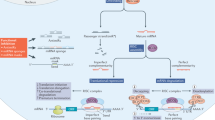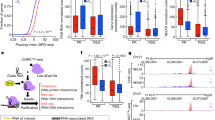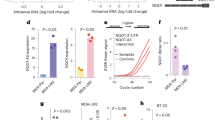Abstract
Agents that activate expression of specific genes to probe cellular pathways or alleviate disease would go beyond existing approaches for controlling gene expression. Duplex RNAs complementary to promoter regions can repress or activate gene expression. The mechanism of these promoter-directed antigene RNAs (agRNAs) has been obscure. Other work has revealed noncoding transcripts that overlap mRNAs. The function of these noncoding transcripts is also not understood. Here we link these two sets of enigmatic results. We find that antisense transcripts are the target for agRNAs that activate or repress expression of progesterone receptor (PR). agRNAs recruit Argonaute proteins to PR antisense transcripts and shift localization of the heterogeneous nuclear ribonucleoprotein-k, RNA polymerase II and heterochromatin protein 1γ. Our data demonstrate that antisense transcripts have a central role in recognition of the PR promoter by both activating and inhibitory agRNAs.
This is a preview of subscription content, access via your institution
Access options
Subscribe to this journal
Receive 12 print issues and online access
$189.00 per year
only $15.75 per issue
Buy this article
- Purchase on Springer Link
- Instant access to full article PDF
Prices may be subject to local taxes which are calculated during checkout






Similar content being viewed by others
References
Morris, K.V., Chan, S.W., Jacobsen, S.E. & Looney, D.J. Small interfering RNA-induced transcriptional silencing in human cells. Science 305, 1289–1292 (2004).
Ting, A.H., Schuebel, K.E., Herman, J.G. & Baylin, S.B. Short double-stranded RNA induces transcriptional gene silencing in human cells in the absence of DNA methylation. Nat. Genet. 37, 906–910 (2005).
Janowski, B.A. et al. Inhibition of gene expression at transcription start sites using antigene RNAs (agRNAs). Nat. Chem. Biol. 1, 216–222 (2005).
Janowski, B.A. et al. Involvement of Ago1 and Ago2 in mammalian transcriptional silencing. Nat. Struct. Mol. Biol. 13, 787–792 (2006).
Kim, D.H., Villeneuve, L.M., Morris, K.V. & Rossi, J.J. Argonaute-1 directs siRNA-mediated transcriptional gene silencing in human cells. Nat. Struct. Mol. Biol. 13, 793–797 (2006).
Li, L.C. et al. Small dsRNAs induce transcriptional activation in human cells. Proc. Natl. Acad. Sci. USA 103, 17337–17342 (2006).
Janowski, B.A. et al. Activating gene expression in mammalian cells with promoter-targeted duplex RNAs. Nat. Chem. Biol. 3, 166–173 (2007).
Meister, G. et al. Human Argonaute2 mediates RNA cleavage targeted by miRNAs and siRNAs. Mol. Cell 15, 185–197 (2004).
Liu, J. et al. Argonaute2 is the catalytic engine of mammalian RNAi. Science 305, 1437–1441 (2004).
Kastner, P. et al. Two distinct estrogen-regulated promoters generate transcripts encoding the two functionally different human progesterone receptor forms A and B. EMBO J. 9, 1603–1614 (1990).
Corey, D.R. RNAi learns from antisense. Nat. Chem. Biol. 3, 8–11 (2007).
Grewal, S.I.S. & Elgin, S.C.R. Transcription and RNA interference in the formation of heterochromatin. Nature 447, 399–406 (2007).
Buhler, M., Verdel, A. & Moazed, D. Tethering RITS to a nascent transcript initiates RNAi- and heterochromatin-dependent gene silencing. Cell 125, 873–886 (2006).
Nelson, P.T. et al. A novel monoclonal antibody against human Argonaute proteins reveals unexpected characteristics of miRNAs in human blood cells. RNA 13, 1787–1792 (2007).
Gilbert, C., Kristjuhan, A., Winkler, G.S. & Svejstrup, J.Q. Elongator interactions with nascent mRNA revealed by RNA immunoprecipitation. Mol. Cell 14, 457–464 (2004).
Bomsztyk, K., Denisenko, O. & Ostrowski, J. hnRNP K: one protein, multiple processes. Bioessays 26, 629–638 (2004).
Zofall, M. & Grewal, S.L. Swi6/HP1 recruits a JmjC domain protein to facilitate transcription of heterochromatic repeats. Mol. Cell 22, 681–692 (2006).
Vakoc, C.R., Mandat, S.A., Olenchock, B.A. & Blobel, G.A. Histone H3 lysine 9 methylation and HP1γ are associated with transcription elongation through mammalian chromatin. Mol. Cell 19, 381–391 (2005).
Eissenberg, J.C. & Shilatifard, A. Leaving a mark: the many footprints of the elongating RNA polymerase II. Curr. Opin. Genet. Dev. 16, 184–190 (2006).
Smallwood, A., Black, J.C., Tanese, N., Pradan, S. & Carey, M. HP1-mediated silencing targets PolII coactivator complexes. Nat. Struct. Mol. Biol. 15, 318–320 (2008).
Check, E. RNA interference: hitting the switch. Nature 448, 855–858 (2007).
Lee, Y.J. & Gorski, J. Estrogen-induced transcription of the progesterone receptor gene does not parallel estrogen receptor occupancy. Proc. Natl. Acad. Sci. USA 93, 15180–15184 (1996).
Hurd, C. et al. Hormonal regulation of the p53 tumor suppressor protein in T47D human breast carcinoma cell line. J. Biol. Chem. 270, 28507–28510 (1995).
RIKEN Genome Exploration Research Group and Genome Science Group (Genome Network Project Core Group) and the FANTOM Consortium. Antisense transcription in the mammalian transcriptome. Science 309, 1564–1566 (2005).
ENCODE Project Consortium. Identification and analysis of functional elements in 1% of the human genome by the ENCODE pilot project. Nature 447, 799–816 (2007).
Gingeras, T.R. Origin of phenotypes: genes and transcripts. Genome Res. 17, 682–690 (2007).
Nicolas, E. et al. Distinct roles of HDAC complexes in promoter silencing, antisense suppression and DNA damage protection. Nat. Struct. Mol. Biol. 14, 372–380 (2007).
Carrozza, M.J. et al. Histone H3 methylation by Set2 directs deacetylation of coding regions by Rpd3S to suppress spurious intragenic transcription. Cell 123, 581–592 (2005).
Mattick, J.S. A new paradigm for developmental biology. J. Exp. Biol. 210, 1526–1547 (2007).
Vasudevan, S., Tong, Y. & Steitz, J.A. Switching from repression to activation: microRNAs can up-regulate translation. Science 318, 1931–1934 (2007).
Martianov, I. et al. Repression of the human dihydrofolate reducase gene by a noncoding interfering transcript. Nature 445, 666–700 (2007).
Han, J., Kim, D. & Morris, K.V. Promoter-associated RNA is required for RNA-directed transcriptional gene silencing in human cells. Proc. Natl. Acad. Sci. USA 104, 12422–12427 (2007).
Janowski, B.A., Hu, J. & Corey, D.R. Antigene inhibition by peptide nucleic acids and duplex RNAs. Nat. Protocols 1, 436–443 (2006).
Hardy, D.B., Janowski, B.A., Corey, D.R. & Mendelson, C.R. Progesterone impairs the interleukin-1β stimulation of cyclooxygenase 2 (COX-2) gene expression in human myometrial cells. Mol. Endocrinol. 20, 2724–2733 (2006).
Mizuno, Y. et al. Increased specificity of reverse transcription priming of trehalose and oligo-blockers allows high efficiency window separation of mRNA display. Nucleic Acids Res. 27, 1345–1349 (1999).
Kraynack, B.A. & Baker, B.F. Small interfering RNAs containing full 2′-O-methylribonucleotide-modified sense strands display Argonaute2/eIF2C2-dependent activity. RNA 12, 163–176 (2006).
Acknowledgements
This work was supported by grants from the US National Institutes of Health (NIGMS 60642, 77253 and 73042 to D.R.C. and EB 05556 to J.C.S.) and Robert A. Welch Foundation (I-1244). We thank Z. Mourelatos (University of Pennsylvania) for providing anti-AGO antibody and D. Shames for helpful discussions.
Author information
Authors and Affiliations
Contributions
J.C.S., S.T.Y., N.-B.N., D.B.H. and B.A.J. designed and performed experiments. B.P.M. synthesized single-stranded oligonucleotides for inhibiting expression of PR antisense transcript. D.R.C. and B.A.J. supervised experiments.
Corresponding authors
Supplementary information
Supplementary Text and Figures
Supplementary Figures 1–5 and Supplementary Tables 1–3 (PDF 318 kb)
Rights and permissions
About this article
Cite this article
Schwartz, J., Younger, S., Nguyen, NB. et al. Antisense transcripts are targets for activating small RNAs. Nat Struct Mol Biol 15, 842–848 (2008). https://doi.org/10.1038/nsmb.1444
Received:
Accepted:
Published:
Issue Date:
DOI: https://doi.org/10.1038/nsmb.1444
This article is cited by
-
RNA activation in ticks
Scientific Reports (2023)
-
Approaches to Gene Modulation Therapy for ALS
Neurotherapeutics (2022)
-
Dissecting the transcriptional regulatory networks of promoter-associated noncoding RNAs in development and cancer
Journal of Experimental & Clinical Cancer Research (2020)
-
Advances in oligonucleotide drug delivery
Nature Reviews Drug Discovery (2020)
-
The YY1/miR-548t-5p/CXCL11 signaling axis regulates cell proliferation and metastasis in human pancreatic cancer
Cell Death & Disease (2020)



